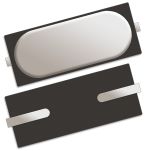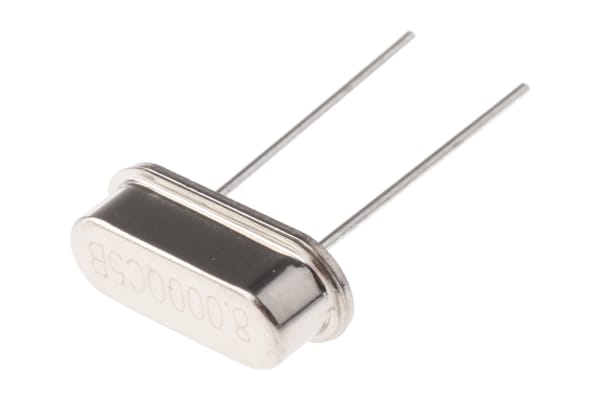Crystals, Oscillators & Resonators
A crystal oscillator is an electromechanical device, it’s also an electronic oscillator circuit. The main purpose of an oscillator is to make use of a quartz crystal as a frequency. Crystal oscillators use the mechanical resonance of a vibrating crystal, which is made up of a piezoelectric material. This process allows the oscillator to create and obtain an electric signal with a high precision frequency.Where Crystal Oscillators are used?This type of frequency is mostly used to keep track of time within a wristwatch or a digital integrated circuit, to provide a stable clock signal. This is where this signal gained it’s commonly referred to as “clock signal”. This clock signal is used to synchronise the operation of the other electronic devices that make up the system the oscillator is housed in. An oscillator is also used to help stabilise frequencies for radio transmitters and receivers, used in clocks (clock oscillator), computers and cell phones. Quartz crystal can also be found inside test and measurement equipment such as counters, signal generators and oscilloscopes.A little more information on Crystal OscillatorsCrystal oscillators are known to be superior to ceramic resonators, this is for a multitude of reasons. They offer higher stability, they’re higher quality and are considerably lower in cost and more compact in size.Quartz crystals are manufactured for frequencies that range from a few tens of kilohertz all the way up to hundreds of megahertz.Types of Crystal OscillatorsTCXO – These are used when a temperature stability is needed and can’t be attained through a standard crystal oscillator (XO) or a voltage-controlled crystal oscillator (VCXO).OCXO – This is an oven-controlled crystal oscillator, a type of oscillator that achieves the highest frequency stability that a quartz crystal can. They are designed to operate inside a temperature-controlled oven, they are physically larger and require more power to run.VCXO – This is a voltage-controlled crystal oscillator, it controls the change in crystal output by using a DC (direct current) voltage.
-
QANTEK 25MHz Crystal ±20ppm HC-49/U-S SMD 2-Pin 11.4 x 4.8 x 4.4mm
VND0.00 -
QANTEK 25MHz Crystal ±20ppm HC-49/U-S SMD 2-Pin 11.4 x 4.8 x 4.4mm
VND88,128.00Bag (1 Bag of 10) -
QANTEK 32.768kHz Crystal ±20ppm SMD 2-Pin 3.2 x 1.5 x 0.65mm
VND76,704.00Bag (1 Bag of 5) -
QANTEK 8MHz Crystal ±20ppm HC-49/U-S 2-Pin 11.05 x 4.65 x 3.5mm
VND0.00 -
QANTEK 8MHz Crystal ±20ppm HC-49/U-S 2-Pin 11.05 x 4.65 x 3.5mm
VND63,444.00Bag (1 Bag of 10) -
QANTEK, 50MHz XO Oscillator, ±50ppm HCMOS, 14-Pin DIP14 QX14T50B50.00000B50TT
VND0.00 -
QANTEK, 50MHz XO Oscillator, ±50ppm HCMOS, 14-Pin DIP14 QX14T50B50.00000B50TT
VND106,080.00 -
RALTRON 16MHz Crystal ±50ppm HC-49-S 2-Pin 11.35 x 5 x 3.5mm
VND54,468.00Reel (1 Reel of 10) -
RS PRO 10MHz TCXO Oscillator, CMOS ±50ppm
VND0.00 -
RS PRO 12.8MHz TCXO Oscillator, HCMOS, TTL ±0.028ppm
VND0.00 -
RS PRO 12MHz Crystal ±30ppm 2-Pin 11.35 x 5 x 3.5mm
VND0.00 -
RS PRO 16MHz Crystal ±30ppm 2-Pin 11.35 x 5 x 3.5mm
VND0.00 -
RS PRO 16MHz Crystal ±30ppm 2-Pin 11.35 x 5 x 3.5mm
VND0.00 -
RS PRO 16MHz Crystal ±30ppm 2-Pin 11.35 x 5 x 3.5mm
VND0.00 -
RS PRO 32.768kHz Crystal ±10ppm 2-Pin 2.1 x 6.2mm
VND0.00 -
RS PRO 32MHz TCXO Oscillator, Clipped Sinewave ±0.5ppm
VND0.00 -
RS PRO 4MHz Crystal ±30ppm 2-Pin 11.35 x 5 x 3.5mm
VND0.00







